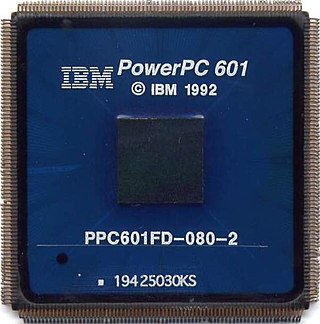
In computing, the Executable and Linkable Format, is a common standard file format for executable files, object code, shared libraries, and core dumps. First published in the specification for the application binary interface (ABI) of the Unix operating system version named System V Release 4 (SVR4), and later in the Tool Interface Standard, it was quickly accepted among different vendors of Unix systems. In 1999, it was chosen as the standard binary file format for Unix and Unix-like systems on x86 processors by the 86open project.

NeXT, Inc. was an American technology company headquartered in Redwood City, California that specialized in computer workstations for higher education and business use. The company was founded by Apple Computer co-founder and CEO Steve Jobs after he was forcibly removed from Apple in 1985. NeXT introduced its first product, the NeXT Computer, in 1988, followed by the smaller NeXTcube and NeXTstation in 1990. These computers had relatively limited sales, with only about 50,000 units shipped in total. Nevertheless, their object-oriented programming and graphical user interfaces were trendsetters of computer innovation, and highly influential.

PowerPC is a reduced instruction set computer (RISC) instruction set architecture (ISA) created by the 1991 Apple–IBM–Motorola alliance, known as AIM. PowerPC, as an evolving instruction set, has been named Power ISA since 2006, while the old name lives on as a trademark for some implementations of Power Architecture–based processors.
The 88000 is a RISC instruction set architecture developed by Motorola during the 1980s. The MC88100 arrived on the market in 1988, some two years after the competing SPARC and MIPS. Due to the late start and extensive delays releasing the second-generation MC88110, the m88k achieved very limited success outside of the MVME platform and embedded controller environments. When Motorola joined the AIM alliance in 1991 to develop the PowerPC, further development of the 88000 ended.
The Motorola 68000 series is a family of 32-bit complex instruction set computer (CISC) microprocessors. During the 1980s and early 1990s, they were popular in personal computers and workstations and were the primary competitors of Intel's x86 microprocessors. They were best known as the processors used in the early Apple Macintosh, the Sharp X68000, the Commodore Amiga, the Sinclair QL, the Atari ST, the Sega Genesis, the Capcom System I (Arcade), the AT&T UNIX PC, the Tandy Model 16/16B/6000, the Sun Microsystems Sun-1, Sun-2 and Sun-3, the NeXT Computer, NeXTcube, NeXTstation, and NeXTcube Turbo, the Texas Instruments TI-89/TI-92 calculators, the Palm Pilot and the Space Shuttle. Although no modern desktop computers are based on processors in the 680x0 series, derivative processors are still widely used in embedded systems.

The AIM alliance, also known as the PowerPC alliance, was formed on October 2, 1991, between Apple, IBM, and Motorola. Its goal was to create an industry-wide open-standard computing platform based on the POWER instruction set architecture. It was intended to solve legacy problems, future-proof the industry, and compete with Microsoft's monopoly and the Wintel duopoly. The alliance yielded the launch of Taligent, Kaleida Labs, the PowerPC CPU family, the Common Hardware Reference Platform (CHRP) hardware platform standard, and Apple's Power Macintosh computer line.

Norsk Data was a minicomputer manufacturer located in Oslo, Norway. Existing from 1967 to 1998, it had its most active period from the early 1970s to the late 1980s. At the company's peak in 1987, it was the second largest company in Norway and employed over 4,500 people.

Dolphin Interconnect Solutions is a privately held manufacturer of high-speed data communication systems headquartered in Oslo, Norway and Woodsville, New Hampshire, USA.

A/UX is a Unix-based operating system from Apple Computer for Macintosh computers, integrated with System 7's graphical interface and application compatibility. It is Apple's first official Unix-based operating system, launched in 1988 and discontinued in 1995 with version 3.1.1. A/UX requires select 68k-based Macintosh models with an FPU and a paged memory management unit (PMMU), including the Macintosh II, SE/30, Quadra, and Centris series.
OSF/1 is a variant of the Unix operating system developed by the Open Software Foundation during the late 1980s and early 1990s. OSF/1 is one of the first operating systems to have used the Mach kernel developed at Carnegie Mellon University, and is probably best known as the native Unix operating system for DEC Alpha architecture systems.
Aviion was a series of computers from Data General that were the company's main product from the late 1980s until the company's server products were discontinued in 2001. Earlier Aviion models used the Motorola 88000 CPU, but later models moved to an all-Intel solution when Motorola stopped work on the 88000 in the early 1990s. Some versions of these later Intel-based machines ran Windows NT, while higher-end machines ran the company's flavor of Unix, DG/UX.

The Santa Cruz Operation, Inc. was an American software company, based in Santa Cruz, California, that was best known for selling three Unix operating system variants for Intel x86 processors: Xenix, SCO UNIX, and UnixWare.

PRISM was a 32-bit RISC instruction set architecture (ISA) developed by Digital Equipment Corporation (DEC). It was the outcome of a number of DEC research projects from the 1982–1985 time-frame, and the project was subject to continually changing requirements and planned uses that delayed its introduction. This process eventually decided to use the design for a new line of Unix workstations. The arithmetic logic unit (ALU) of the microPrism version had completed design in April 1988 and samples were fabricated, but the design of other components like the floating point unit (FPU) and memory management unit (MMU) were still not complete in the summer when DEC management decided to cancel the project in favor of MIPS-based systems. An operating system codenamed MICA was developed for the PRISM architecture, which would have served as a replacement for both VAX/VMS and ULTRIX on PRISM.

RISC iX is a discontinued Unix operating system designed to run on a series of workstations based on the Acorn Archimedes microcomputer. Heavily based on 4.3BSD, it was initially completed in 1988, a year after Arthur but before RISC OS. It was introduced in the ARM2-based R140 workstation in 1989, followed up by the ARM3-based R200-series workstations in 1990.
The Advanced Computing Environment (ACE) was defined by an industry consortium in the early 1990s to be the next generation commodity computing platform, the successor to personal computers based on Intel's 32-bit instruction set architecture. The effort found little support in the market and dissolved due to infighting within the group and a lack of sales.

Univel, Inc. was a joint venture of Novell and AT&T's Unix System Laboratories (USL) that was formed in December 1991 to develop and market the Destiny desktop Unix operating system, which was released in 1992 as UnixWare 1.0. Univel existed only briefly in the period between AT&T initially divesting parts of USL in 1991, and its eventual outright purchase by Novell, which completed in June 1993, thereby acquiring rights to the Unix operating system. Novell merged USL and Univel into their new Unix Systems Group (USG).
Encore Computer was an early pioneer in the parallel computing market, based in Marlborough, Massachusetts. Although offering several system designs beginning in 1985, they were never as well known as other companies in this field such as Pyramid Technology, Alliant, and the most similar systems Sequent and FLEX.

The MC88110 was a microprocessor developed by Motorola that implemented the 88000 instruction set architecture (ISA). The MC88110 was a second-generation implementation of the 88000 ISA, succeeding the MC88100. It was designed for use in personal computers and workstations.

The MC88100 is a microprocessor developed by Motorola that implemented 88000 RISC instruction set architecture. Announced in 1988, the MC88100 was the first 88000 implementation. It was succeeded by the MC88110 in the early 1990s.
The Application Programming Interface for Windows (APIW) Standard is a specification of the Microsoft Windows 3.1 API drafted by Willows Software. It is the successor to previously proposed Public Windows Interface standard. It was created in an attempt to establish a vendor-neutral, platform-independent, open standard of the 16-bit Windows API not controlled by Microsoft.













